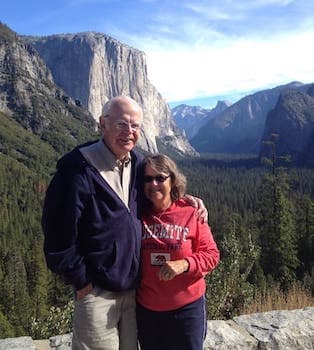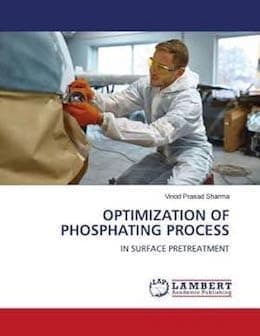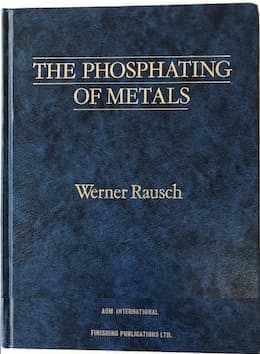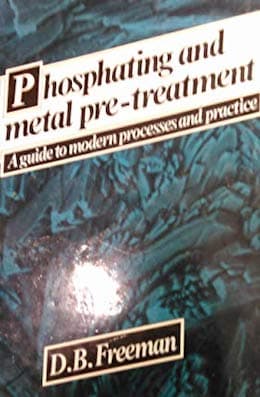
-----
Tri-cationic Zinc Phosphating?
Quickstart:
There are several types of phosphating treatments -- zinc phosphating being one of the most common. It is a very effective pretreatment before painting or powder coating of steel, improving adhesion of the paint, greatly improving the corrosion resistance, minimizing galvanic hot spots, etc.
As with most finishes, "tweaks" have been developed which can improve it. One tweak for zinc phosphating is tri-cationic phosphating where manganese and nickel are added to the zinc.
The phosphate solution itself usually comprises only one of several (usually 5 or 7) steps including cleaning, rinsing, acid activation, and a final DI rinse or passivation dip.
Q. Hi, this is Gautam Wadekar from Mumbai, and I need some help regarding standards for tri-catonic zinc phosphating because every chemical supplier gives different ranges like:
F.A. 18 -22 / 22 - 28 / 26 - 30 ml
T.A. 0.8 - 1.2 ml / 1 - 3 ml

Gautam wadekar
paint and coating technologist - Mumbai, India
March 10, 2025
A. Hi Gautam. We have many threads about FA/TA if you search the site for the term "FA TA". Thread 473/51 is a good one, where Robert Probert explains that mis-measurement is easy and can complicate the problem. Thread 168/27 should also be helpful.
But the reason chemical suppliers suggest different ranges is probably that their formulations differ enough from each other to justify it (different steel substrates can profit from different ratios too). The best answer is probably to try to hold the FA and TA to the values which your own supplier suggests; getting all to agree may be like herding cats. Good luck.
Luck & Regards,

Ted Mooney, P.E. RET
Striving to live Aloha
finishing.com - Pine Beach, New Jersey
⇩ Related postings, oldest first ⇩
Q. I am a metal engineer. I am studying about conversion coating (tri-cationic phosphating bath). My coating bath is from Henkel company.
My process stages consist of:
• oil cleaning
• acid washing (sulfuric acid 5%)
• water rinse
• phosphating bath
• water rinse
The way of coating is immersion method.
The resulting coating is very smooth, dense and light gray color ... but after two time immersion coating the bath is not working good (my pieces are st37 steel plates.
How can I improve the bath?
What are the best conditions of my bath?
Must I add other materials into the working bath?
What must I add to the bath for increase the salt spray time?
My bath sludge is very high. How can I solve this problem.
The water that I use is very hard. How can I solve this problem?
amirkabir - Tehran
2005
A. You should go back to Henkel and get some more advice. It is not normal at all to have an acid degreasing tank prior to Zinc Phosphating; this should be an alkali cleaning degreasing bath. Prior to Tricat phosphate it is normal to have:
alkali wash
2x rinse
conditioning rinse or conditioner spray
tricationic phosphate.
- Lincs, UK
A. Dear Mr.Hamed,
Please ensure the ratio of total acid to free acid per 10 lots, also ensure accelerator concentration in the bath.
You need to maintain TA:FA ratio along with the concentration of an accelerator. This will help you for consistent results.
You can also off-line your derusting (Acid) bath for better maintenance of your phosphate bath.
- Aurangabad, Maharashtra, India
August 19, 2010

avail from AbeBooks, or Amazon

avail from eBay, AbeBooks, or Amazon

avail from eBay, AbeBooks, or Amazon
(as an Amazon Associate & eBay Partner, we earn from qualifying purchases)
Q. Hello.
What do I do to improve the zinc pot bath?
Thank you.
- Iran
2005
A. More words please, Mr. Biabani. I don't understand even very generally what you are doing yet, let alone any of your details. Thanks.

Ted Mooney, P.E.
Striving to live Aloha
finishing.com - Pine Beach, New Jersey
Q. Hi, please tell me formula of tri-cationic phosphating.
Sunil Junejabuyer - Faridabad, Haryana, India
March 28, 2009
A. Hi, Sunil,
A tri-cationic phosphate is one that contains ions of zinc, manganese, and nickel. There are many patents on the subject, and consequently many different formulations. The usual idea is that you buy one from your pretreatment supplier and follow the instructions on their technical data sheet. It may be possible to formulate a tri-cationic phosphate yourself, but I am not personally aware of any generic formulas. You could search expired patents. Good luck!
Regards,

Ted Mooney, P.E.
Striving to live Aloha
finishing.com - Pine Beach, New Jersey
A. Ah! At last somebody wants to know this! Good.
Ted is right, Actually we are manufacturers of metal pretreatment chemicals. It is a combination of 3 cations namely, ZINC, MANGANESE and NICKEL, all in a fixed combined proportion.
Technically speaking this is the best form of phosphating available. The mother liquor of such phosphating solution will be PALE GREEN, and the colour of the solution in the tank will be sea green.
This can be operated in a COLD system giving excellent results, so I don't understand why people operate in hot.
Such phosphating gives excellent corrosion resistance in a salt spray chamber with low micron build up; the coating is smooth and is user friendly. Take care to maintain TOTAL ACID, and FREE ACID in the tank, and use accelerator properly.
- Coimbatore, Tamilnadu, INDIA
A. Hi Mr.Sunil Juneja,
As Mr.Ted Mooney said, Tri cationic phosphate contains Zinc , Nickel & Manganese. Zinc improves adhesion, Nickel contributes to corrosion protection & Manganese improves wear resistance. There is no generic formula or chemistry available to manufacture this chemicals since there are many patents and formulations. I am sure no one will give you the formulations. Hence it is advised to discuss with pretreatment chemical supplier for the products.
Mr. Shankar Omprakash Khandelwal has referred to cold phosphating. But please understand the process time, Phosphate coating weight, Crystal structure(SEM pictures),P - ratio are not the same between cold & hot phosphates. It is the main reason mostly hot phosphate process is preferred over cold phosphating.
Thanks,

P.M.Saravanan
paint shop manager
Chennai, Tamilnadu, India
A. Hi Sunil
Tri-cation Phosphate (TCP) means combination of Zn, Ni, Mg cation in phosphoric acid and chlorate; nitrate was also used in accelerator to increase rate of reaction. TCP is preferred in hot process because of formation of required coating weight and granule size.
THANKS,
- DELHI, INDIA
A. Sir,
Tri-cationic phosphating is based on Zn, Ni, & Mn.
The concentration of Total acid with Free acid needs to be maintained very strictly. To get better result, auto-dosing of Accelerator (on the basis of consumption/lot) needs to be procured.
- Aurangabad -Maharashtra India
|
|
Q. Dear sir, - Mumbai, Maharashtra, India February 10, 2012 A. Hi, Mitesh. Sorry, but it isn't clear whether you are referring to tri-cationic Zn-Ni-Mn as three-in-one here, or whether your question actually refers to a different topic, the iron phosphate process which does cleaning/activating/phosphating in a single tank so is sometimes called three-in-one. But several people on this page have already told us that tricationic phosphating is proprietary, not generic, and nobody will blow their trade secrets and tell you the "exact formulation" of a proprietary process. You might as well ask for the shop drawings for a Lexus :-)  Ted Mooney, P.E. Striving to live Aloha finishing.com - Pine Beach, New Jersey |
Q. I want to ask the method to determine Phosphate ion and zinc ion in Tri-cationic phosphating bath in order to monitor the coating pattern on mild steel.
Thanks and regards
- lahore, Pakistan
July 6, 2012
⇦ Tip: Readers want to learn from your situation;
so some readers skip abstract questions.
Q. Comparison between Di-cation Phosphating Process vs. Tri-cation Phosphating Process.
Sharad Dhanait- Nashik, India
March 22, 2013
A. The Di-cationic is having two cations (e.g.Zinc and Calcium) while Tr-cationic is having three cations (Zinc, Nickel and Mn) in Phosphoric acid.
Rahul Deshpande- Aurangabad, Maharashtra
A. Hi Sharad. Assuming that by "di-cationic" you mean zinc+nickel, rather than "calcium modified" , the advantage of the addition of manganese is probably adhesion and durability for better wear and tear performance.
Please try to explain your actual situation, and you will probably get enthusiastic, well-directed help tailored to your needs in this forum; broad, abstract questions usually can't be properly addressed with short answers -- so they are less appropriate to a public forum and answered better, with deeper insight, by chapters in books.
From running this forum for decades now, my advice is that readers love to hear about, help out with, and learn from the actual situations that people are faced with ... but they will virtually never expend the effort to try to condense a book chapter down to 3 or 4 paragraphs in response to an abstract sentence fragment.
Good luck,
Regards,

Ted Mooney, P.E.
Striving to live Aloha
finishing.com - Pine Beach, New Jersey
⇦ Tip: Readers want to learn from your situation;
so some readers skip abstract questions.
Q. Does the square feet area of components to be dipped in pre-treatment and tri-cationic phosphate bath affect the quality of pre-treatment and phosphate respectively?
Rahul Deshpande- Aurangabad, Maharashtra
December 12, 2013
Q. Respected sirs,
I am using di-cationic zinc phosphating chemical; as well, my chemical supplier is also saying our phosphating product is di-cationic. But how will we prove it. If you have any method for cation testing please explain.

This meeting place welcomes Q&As, photos, history, & interesting tidbits 🙂
Please engage with other posters
• When people show interest in each other's situations, the page quickly becomes a fun & informative learning experience for everyone !
• When people show no interest in other people's postings, and just post their own, it often quickly deteriorates into a string of unanswered questions
- MAHARASHTRA, INDIA
December 12, 2013
Q. Hi. I want comparison between tri and di Cationic, and disadvantages of each of them.
Do you have any paper?
Thank you.
- thehran, iran
December 29, 2014
Q. How to find if our phosphating is di-cation or tri-cation. How justify of its.
Supinder SharmaPaint shop employee - Gurgaon India
April 13, 2018
Q, A, or Comment on THIS thread -or- Start a NEW Thread
